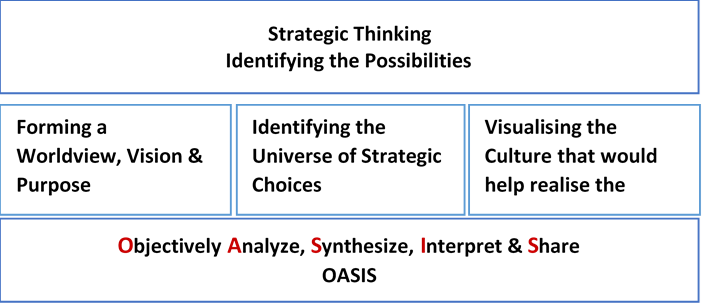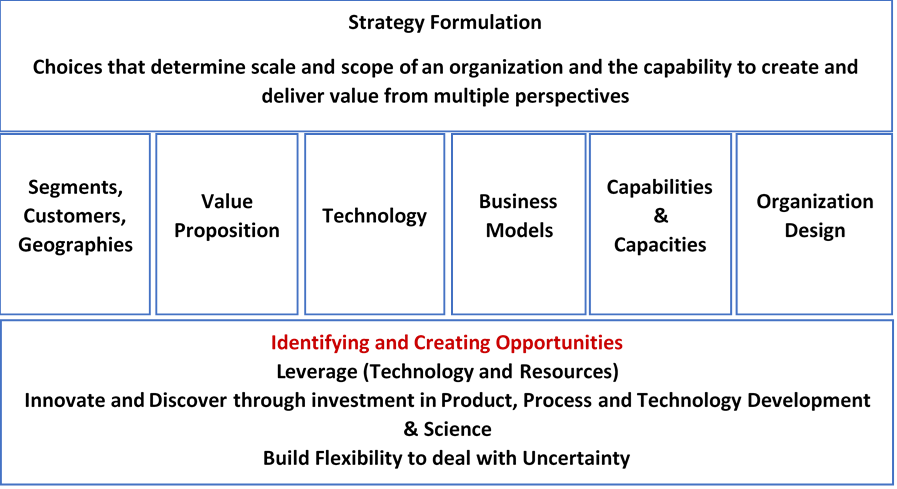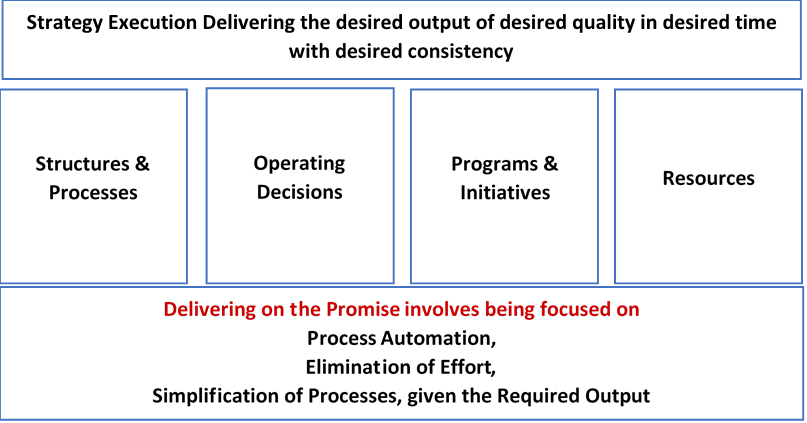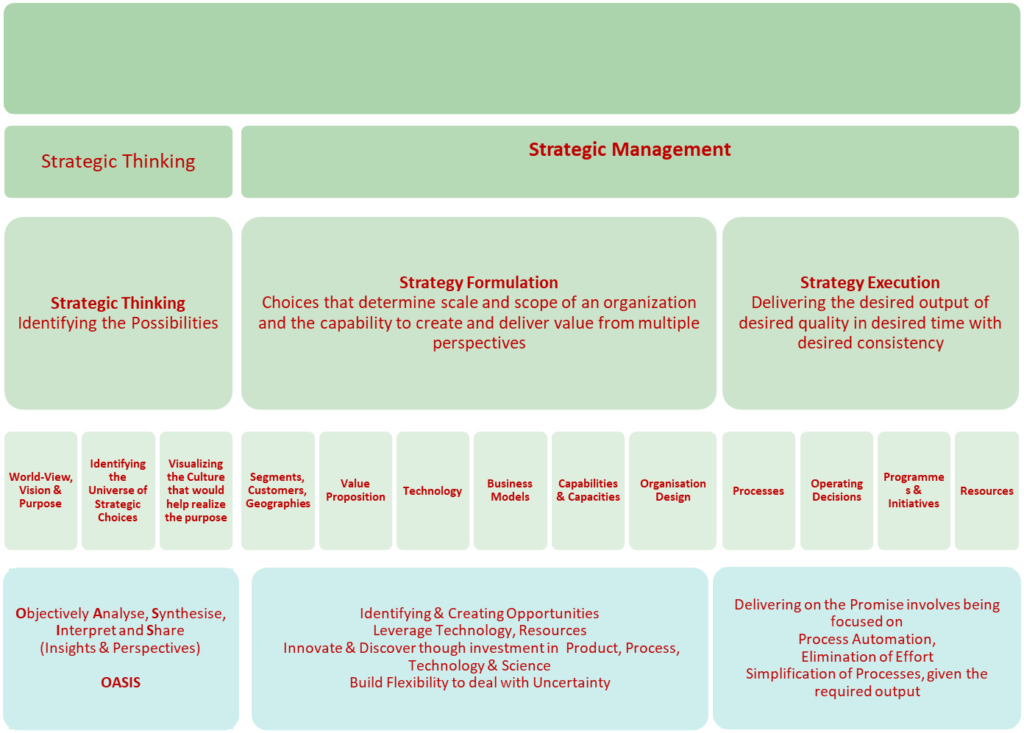Strategy – The Journey from Thinking to Execution
Derived from the Greek word stratēgia[i] which means “the function of a general”, strategy is often used to describe a high-level path to achieve one or more goals under conditions of uncertainty and was initially used to describe military actions.
In a corporate environment, strategy has come to denote deliberate course of actions that organizations intend to take for the benefit of internal and external stakeholders.
Alfred D Chandler[ii] defined it as the “determination of the basic long-term goals and objectives of an enterprise and the adoption of courses of action and the allocation of resources for carrying out the goals.”
Kenneth Andrews[iii] called it the “pattern of decisions in a company that determines and reveals objectives, purposes or goals, produces the principal policies and plans for achieving those goals and defines the range of businesses the company is to pursue, the kind of economic and human organization it intends to be, and the nature of the economic and non-economic contribution it intends to make to its shareholders, employees and communities”.
A more recent definition by Max McKeown[iv] argues that “strategy is about shaping the future” and is the human attempt to get to “desirable ends with available means”.
Strategy is an articulation of the direction and intended destination of an organization and encompasses the ideas that need to be pursued to reach that destination. This process for defining a strategy has been alternatively called strategic thinking, strategic management and even strategic planning.
Strategic Planning as practiced by many organizations, using excel-based templates, is a tool for strategy implementation – a tool that allows the organization to convert ideas into numbers and review performance around specifically quantified objectives. Strategic thinking, formulation and implementation is about ideas, ideas that help an organization realize its purpose.
This paper aims to describe the path that an enterprise can take to define its strategy – from strategy thinking to strategic execution.
Strategic Thinking – Inspire to Build A Shared View
Gary Hamel and CK Prahalad in their book “Competing for The Future”[v] said that an organization needs to have a strategic intent – which is an ambitious and compelling dream that energizes and provides the emotional and intellectual energy for the journey to the future. This journey, as conceptualized by them, requires organizations to look ahead and construct an integrated perspective of the enterprise by synthesizing institution knowledge (an analysis of the past and present and its impact on the future) and creativity.
This kind of thinking has been described as “Strategic Thinking” and refers to themes of creativity, exploration and understanding discontinuities. It brings together two dichotomous activities – analytic and creative aspects. P. Raimond[vi] divides this into two modes – One a data driven, information processing approach and the second using creative imagination.
Jeane M Liedtka[vii] defined strategic thinking as a particular way of thinking with five specific attributes. An adapted view of the attributes is detailed in the image below.
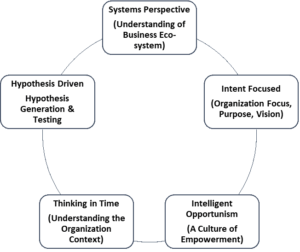
The foundation of strategic thinking is built not just on a complete understanding of the industry that an organization operates but also the business ecosystem in which it operates. An example of looking at the business ecosystem and not just its product is exemplified in the strategy behind Apple Inc’s iPhone, which is not just another communication device but a media and entertainment device that combines the availability of content from multiple sources.
Strategic thinking is intent driven and implies a point of view about the long-term market or competitive position that a firm hopes to build over the coming decade or so. It implies a competitively unique view about the future. It also has an emotional edge to it; it is a goal that employees perceive as worthwhile and implies a sense of destiny (Hamel & Prahalad)[viii]. This intent provides focus and ensures absence of distractions in the organization.
Evidences of this strategic intent are often found in the vision statements of organizations:
- “Empower every person and organization on the planet to achieve more” (Microsoft)[ix].
- “Earth’s most customer -centric company where customers can find and discover anything they might want to buy only and endeavors to offer its customers the lowest possible prices” (Amazon when it launched in 1995 and now identified as part of its DNA)[x]
- “Within arm’s reach of desire” (Coca-Cola)[xi].
The vision that the organization wishes to pursue emerges from thinking ahead and as Henry Mintzberg[xii] mentions, it is about finding the gem of an idea that can change the organization.
The process of understanding the future evolves from understanding the predictive value of the past and what in the present matters for the future. Inherent in the decision-making process is the culture of the organization which empowers all levels of the organization to come up with alternative strategies where required, irrespective of their position in the organization hierarchy.
Scenario building is one of the tools that can be used to start laying down the myriad factors that shape the future or even alternative futures. It is a story that participants charged with laying out the vision build out – a story, which is based on analysis and understanding of current and historic trends and events.
In the “Art of Longview” Peter Schwartz has called out that “Scenario Planning is a powerful method for clarifying perceptions, communicating, integrating quantitative an intuitive planning forcing people to think, working through complexity and influencing an organization without micromanaging.”
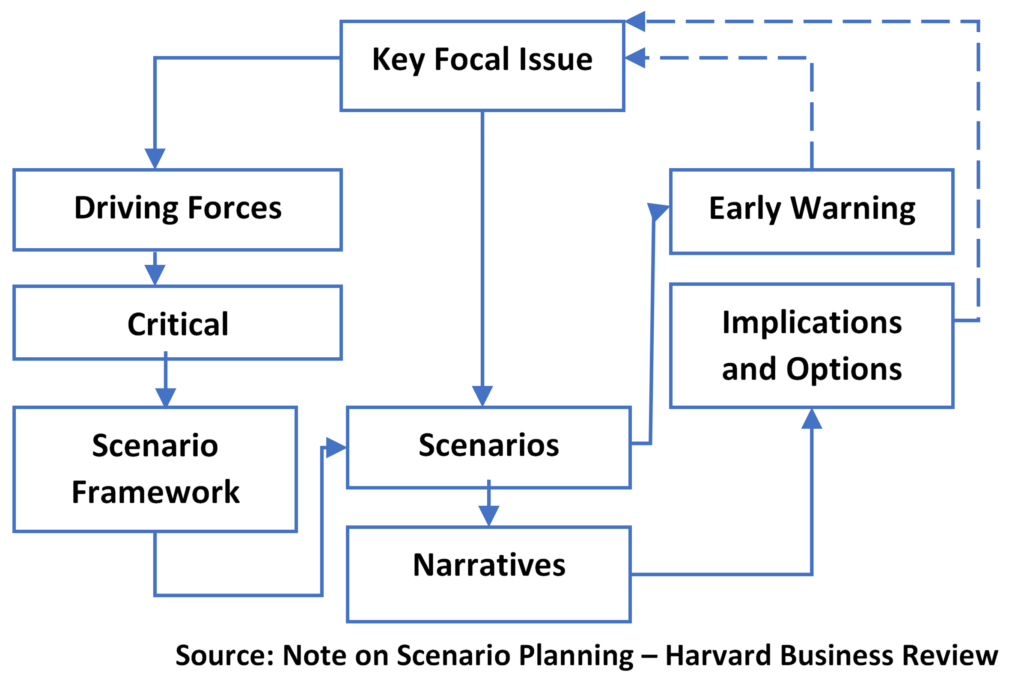
Scenario planning, according to David A Garvin and Lynne C. Levesque[xiii], is built around a Focal Issue –issues that are considered significant, of an upcoming decision of strategic uncertainty that has important long range consequences for the organization over a period of time. These key focal issues emerge from Driving Forces identified through conversations with key stakeholders of the company who include customers, competitors, suppliers. These conversations enable the organization to identify themes and trends that are likely to shape the focal issue in fundamental ways. These Critical Uncertainties could be either predetermined forces, e.g., population demographics or uncertain factors. Each Critical Uncertainty is then analysed for the likely impact and from which a Scenario Framework emerges. The different futures that result from the interaction of the critical, selected, uncertainties are Scenarios. These represent potentially how the world might unfold for the enterprise. Each scenario is then fleshed out and woven as a narrative to understand the journey from the present to the future. The implications and options enable the organization to understand strengths and vulnerabilities, alternative strategies and options, gaps in capabilities and options. This is similar to what Liedtka refers to as the Hypothesis Generation and Testing phase. The Early Warning highlights the likely emergence of one scenario or the other.
Scenario building or any other process followed by an organization helps clarify perceptions and integrate quantitative and intuitive ideas. This process objectively analyzes data of the past and the present and synthesizes this with creative inputs. This interpretation then helps shape options that are available and what needs to be the path an organization can take. This helps create a mental model of what needs to be done.
Strategic Thinking can be visually viewed as follows:
Strategic Formulation – collaboratively making choices that determine scale and scope of an organisation & the capability to create and deliver value
This phase is a dialogue around specific strategic issues, the outcome of which is both a better strategy for an organization and better developed strategic thinking in the organization. This phase represents a detailed analysis of the ideas that have emerged from the process of strategic thinking and examining them from multiple perspectives to make it implementable. Strategic thinking provides the ideas and concepts and strategic formulation helps to root them. Strategy formulation involves reviewing key objectives and strategies of the organization, evaluating the alternatives and deciding on the most appropriate alternative[xiv] (Wheelen & Hunger, 2008). Strategy formulation involves a detailed internal and external analysis of the current business. The areas that need to be covered will include the following:
Market Coverage: Choices of Segments, Customers and Geographies
- It involves understanding who the customers are, which geographies are they present in and what demographic or psychographic segments they are a part of
Value Proposition that Products, Services and Solutions Portfolio Offers
- What products and services does the organization offers? Do they offer value to the customers, and does that value meet their perceived needs? How does the price point affect its value, if at all? What are the end benefits that these products and services have that convince customers to buy them?
- It also involves evaluation of the market position of the organization vis-a vis the competition and what value proposition will enable the organization to reach the desired share.
Business Models that are most suited for a particular stage of Market Evolution
- Identifying the means by which a company aims to provide its products or services and the business models that will need to be pursued/built. For example, the selling of software started as a license-based model with infrequent version releases but has moved to being sold through a subscription-based model with frequent updates in a cloud-based environment.
Technology Portfolio or Platforms that will help create the required Products, Services and Solutions Portfolio
- In today’s context, the choice of technology platform or technology portfolion is as critical as the choice of specific products, services and solutions. For example, 3M’s thousands of products, services and solutions sold globally are based on more than a dozen technologies.
- Technology is not only redefining the product, services or solutions portfolio, it is also redefining the way the organisation is managed and customer experience delivered. For example, the use of ChatBots has transformed people and service interaction. Organizations now can improve the overall engagement process and operational efficiency by reducing the typical cost of customer service.
Capabilities & Capacities required to create, deliver and communicate Value
- At this stage, an organisation reviews the capabilities and capacities in the organization that are needed. What is the current state and what is the gap with the intended state? Should it build capability and capacity through acquisitions?
- As organizations evolve their strategy a key differentiator will be the capability of its organization to deliver on its priorities. For example, as AI becomes all pervasive, an organisation would need to train and orient its workforce realise the potential value of AI across the entire value chain.
Organization Design
- How does the organization make progress in its strategic intent? What would be the optimum design it needs to purse? Organizations structures have evolved considerably over the past three decades[xv] (Boje & Dennehy).
- Attributes of management – from planning to controlling are witnessing a sea change. Structures have evolved from hierarchical to flat.
- Geographic dispersion of leadership and talent has resulted in emergence of distributed production. China has emerged as a manufacturing hub for most technology companies and India as a software development hub, with customers being spread globally.
- Organizations diversity must be inherent in all the organisation processes.
- Continuously evolving business eco-system requires a culture of learning and relearning, with collaboration being built into the structure and processes.
At the broadest level, the output of a strategy formulation process could be statement of and ideas that will help realise the organisation purpose.
An example of the journey from a vision statement to a strategy formulation can be seen in the example below:
Apple’s[xvi] vision statement says “We believe that we are on the face of the earth to make great products and that’s not changing. We are constantly focusing on innovating. We believe in the simple not the complex. We believe that we need to own and control the primary technologies behind the products that we make and participate only in markets where we can make a significant contribution. We believe in saying no to thousands of projects, so that we can really focus on the few that are truly important and meaningful to us. We believe in deep collaboration and cross-pollination of our groups, which allow us to innovate in a way that others cannot. And frankly, we don’t settle for anything less than excellence in every group in the company, and we have the self-honesty to admit when we’re wrong and the courage to change. And I think regardless of who is in what job those values are so embedded in this company that Apple will do extremely well.”
Apple’s press notes call out the following[xvii] in their boilerplate:
“Apple revolutionized personal technology with the introduction of the Macintosh in 1984. Today, Apple leads the world in innovation with iPhone, iPad, Mac, Apple Watch and Apple TV. Apple’s four software platforms — iOS, macOS, watchOS and tvOS — provide seamless experiences across all Apple devices and empower people with breakthrough services including the App Store, Apple Music, Apple Pay and iCloud. Apple’s more than 100,000 employees are dedicated to making the best products on earth, and to leaving the world better than we found it.”
Taken together we can derive the strategic formulation of Apple could be described as follows:
| Customers | Global- Individuals and Enterprises |
| Value Proposition | Constant Innovation for creating the best devices and software and experience |
| Technology | Revolutionary devices and software and controlling the primary technologies behind the products |
| Capability | Innovation and collaboration |
In summary, strategic formulation leads an organization to identify and thereafter create opportunities that will enable it to deliver value to its customers. It is an in-depth review of external and internal factors – market, competition, technology, business models and organization capability. The process involves large segments of the organization since insights need to be drawn from teams and leaders who are actively engaged with customers. In this phase the corporate level strategy will need to be translated into a business level competitive strategy.
The formulation process can be visually seen as follows:
Strategy Execution- Delivering on the Promise
The final phase in the strategic management framework is the strategy execution. In this phase, the strategy is put into action to meet the specific short- and medium-term goals and objectives. As a first step in the process, the strategy needs to be institutionalized to ensure that the organization will rally around. The leadership will need to articulate the culture that will support this change. This step is essential to ensure that the focus is on delivery of the desired result with the desired quality in the desired time with desired consistency.
The next step in implementing the strategy would be enunciating the goals that are aligned to the vision and mission. These goals include market share either in terms of revenue and or usage. This would translate itself into a set of financial goals – Revenue, Margins and Profits. The long-term goals are broken down into a set of monthly, quarterly and annual goals for purposes of regular tracking.
At this stage, the organization needs to allocate resources – people, material, equipment. It needs to pay attention to the training and development of the individuals so that they are well-equipped.
In order to track progress, control systems need to be put in place. Organizations have used multiple tools to drive this process. Management by Objectives, Key Result Areas are some of the tools in vogue. Some organizations use OKRs (Objective, Key Result)[xviii] as they help prioritize in a rapidly changing environment, especially in technology companies. In fast changing environments, the OKR is set up for every quarter by the top management and cascaded and every member in the team will then be able to write up their OKRs in terms of how they will contribute to the north star identified by the management. OKRs are measurable or quantifiable targets.
An organization develops structures, processes and control systems to track progress against the goals. The structure and processes include the “what and how” of tracking goals. It also needs to design an incentive structure for performance that exceeds the objectives or goals. The control system ensures feedback to employees and the organization on organizational and employee performance. The execution phase can be visualized as follows:
Putting it Altogether
Strategy creation in an organization starts with strategic thinking followed by strategy formulation and then implementation. Strategic thinking enables the organization to analyze, be creative and thereafter synthesize a journey that it would like to embark on. Strategy formulation provides the end destination of this journey with a deep dive understanding of external and internal factors that an organization is operating in. Strategic execution is the implementation phase of the journey that requires an organization mandate and processes to review progress.
[i] Definition sourced from https://www.collinsdictionary.com/dictionary/english/strategies
[ii] Alfred D. Chandler, Jr, Strategy and Structure (1962)
[iii] Kenneth Andrews, The Concept of Corporate Strategy (1971) and updated it in 1980
[iv] Max Mckeown, The Strategy Book
[v] G. Hamel and C.K. Prahalad, Competing for the Future, Harvard School Press, 1994
[vi] P. Raimond Two Styles of Foresight, Long Range Planning- 1996
[vii] Jeanne M.Liedtka, Strategic Thinking, Can it be Taught?, Long Range Planning, Vol 31 1998
[viii] G. Hamel and C.K. Prahalad
[ix] https://www.microsoft.com/en-us/about – accessed on March 21st, 2020
[x] https://www.amazon.jobs/en/working/working-amazon/#our-dna accessed on March 21st, 2020
[xi] Sourced from https://www.ft.com/content/f0f57086-bb76-11e4-b95c-00144feab7de
[xii] Henry Mintzberg, Strategic Thinking as “Seeing”, 2018
[xiii] David A Garvin and Lynne C. Levesque, A Note on Scenario Planning, Harvard Business School,2006
[xiv] Wheelen & Hunger, 2008, Concepts in Strategic Management & Business Policy
[xv] Boje & Dennehy, Modern versus Postmodern Principles of Management, 1993
[xvi] https://www.forbes.com/sites/patrickhull/2012/12/19/be-visionary-think-big/#3fee95783c17- Apple’s vision as quoted in a Forbe’s interview with Tim Cook
[xvii] https://www.apple.com/newsroom/2020/01/apple-reports-record-first-quarter-results/ – Apple’s press boilerplate
[xviii] John Doerr, “Measure What Matters”



